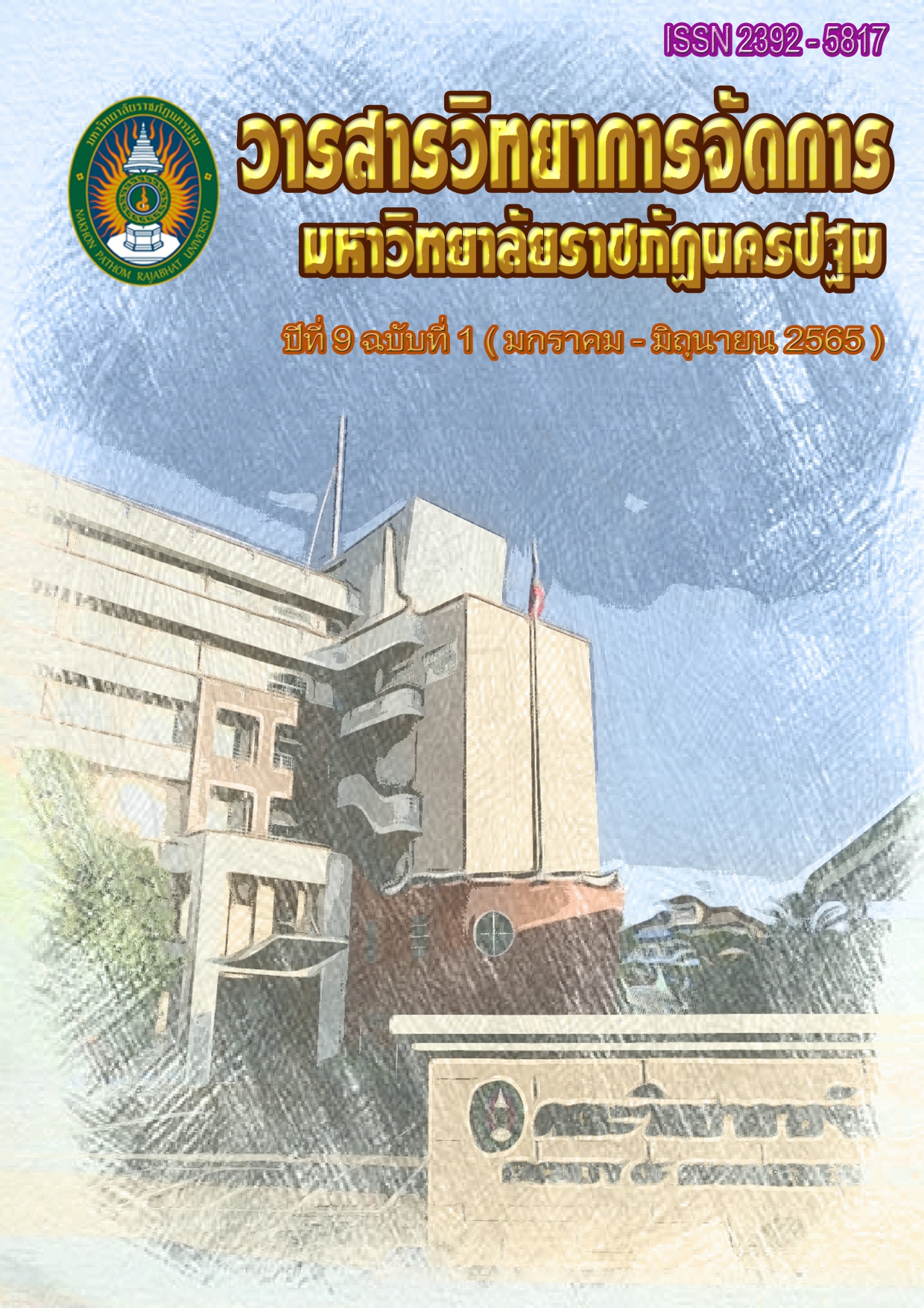Guideline for Human Resource Management to create competitive advantage of Community Enterprise in Suphanburi Province
Main Article Content
Abstract
The objectives of this study were to; 1) study the opinion to human resource management and competitive advantage of Suphanburi Community Enterprise, 2) compare the opinion to human resource management and competitive advantage of Suphanburi Community Enterprise classified by personal factors, 3) investigate factors affecting to Human Resource Management to create competitive advantage of Community Enterprise in Suphanburi Province, and 4) explore the guideline for Human Resource Management to create competitive advantage of Community Enterprise in Suphanburi Province. This study was mixed-method research, and the samples of quantitative research were 163 president or representatives who work as chief executive officers position or have experience in governed field of Suphanburi Community Enterprise using stratified sampling. The collecting instruments used in this study were the questionnaire evaluated the content validity and reliability. The data analysis were percentage, mean, standard deviation, and T-test to compare the factors as personal factors and human resource management factor affecting to competitive advantage of Suphanburi Community Enterprise. Also, the data analysis used Fisher’s Least Significant Difference (LSD) in case of statistically significant difference, Stepwise of Multiple Regression Analysis to identify the relationship between factors affecting to Human Resource Management and competitive advantage. For the qualitative study, the data were collected using the interview. The samples were 5 main informants who are the representative of president or representatives of Suphanburi Community Enterprise who received an outstanding award and cooperated in this research using purposive sampling, and data were analyzed by content analysis.
The results found that;
1) the opinion to Human Resource Management to create competitive advantage of Suphanburi Community Enterprise in overall was at a high level, and in each aspect was at a high level,
2) the different personal factors as age, income per month, experiences in Community Enterprise field, and types of Community Enterprise members affected to the the opinion to Human Resource Management to create competitive advantage of Suphanburi Community Enterprise at the 0.05 statistical significance level followed the hypothesis both in overall and each aspect, and
3) the Human Resource Management factors as Recruitment, Performance Appraisal, and Compensation and Benefits affected to the competitive advantage of Suphanburi Community Enterprise statistically significant followed the predicting hypothesis as 80.50% variation of the competitive advantage of Suphanburi Community Enterprise as the forecasting equation
Y = 0.364** ** + 0.191X2** + 0.398 X5** +0 .308 X6**,
4) the guideline for Human Resource Management to create competitive advantage of Suphanburi Community Enterprise were to study the management from successful organizations, acknowledged and applied with their own Community Enterprises, or supported from various agencies so that they can make competitive advantage.
Article history : Received 24 November 2021
Revised 8 May 2022
Accepted 11 May 2022
SIMILARITY INDEX = 2.69 %
Article Details

This work is licensed under a Creative Commons Attribution-NonCommercial-NoDerivatives 4.0 International License.
The views and opinions of the article appearing in this journal are those of the author. It is not considered a view and responsibility of the editorial staff.
References
กองส่งเสริมวิสาหกิจชุมชน กรมส่งเสริมการเกษตร. (2564). ระบบสารสนเทศวิสาหกิจชุมชน. [ออนไลน์]. สืบค้นเมื่อ 25 มีนาคม 2564. จาก https://smce.doae.go.th/ProductCategory/SmceCategory.php
ชัญภร เสริมศรี. (2558). ความสัมพันธ์ระหว่างการบริหารทรัพยากรมนุษย์กับความผูกพันต่อองค์การของบุคลากร บริษัทแห่งหนึ่ง ในเขตนิคมอุตสาหกรรมอมตะนคร จังหวัดชลบุรี. วิทยานิพนธ์รัฐประศาสนศาสตรมหาบัณฑิต สาขาวิชาการบริหารทั่วไป มหาวิทยาลัยบูรพา.
ฐานเศรษฐกิจ. (2563). ทำไมต้อง “จดทะเบียนวิสาหกิจชุมชน”. [ออนไลน์]. สืบค้นเมื่อ 25 มีนาคม 2564. จาก https://www.thansettakij.com/business/443911
ณัฏฐพันธ์ เขจรนันทน์. (2555). การจัดการทรัพยากรมนุษย์. กรุงเทพฯ: หจก. เม็ดทรายพริ้นติ้ง.
ธีรฉัตร เทียมทอง และเพ็ญณี แนรอท. (2561, ธันวาคม). แนวทางการพัฒนาวิสาหกิจชุมชนที่ยั่งยืน กรณีศึกษาวิสาหกิจชุมชนกลุ่มเลี้ยงปลากระชังแม่น้าโขง บ้านพร้าวใต้ ตำบลหินโงมอำเภอเมืองหนองคาย จังหวัดหนองคาย. วารสารการบริหารปกครอง (Governance Journal). 7 (2), 245-265.
นิภา วิริยะพิพัฒน์. (2559, ธันวาคม). บทบาทของ HRM : การจัดการช่องว่างระหว่างวัยในองค์กร. วารสารวิชาการและการวิจัย มทร.พระนคร สาขามนุษยศาสตร์และสังคมศาสตร์. 1 (2), 73-88.
นิภาพรรณ เจนสันติกุล. (2562, มิถุนายน). การพัฒนาวิสาหกิจชุมชนพื้นที่ภาคกลางตอนล่าง 1 เพื่อยกระดับขีดความสามารถในการแข่งขันในประชาคมอาเซียน. วารสารรัฐศาสตร์และรัฐประศาสนศาสตร์. 10 (1),95-120.
พนิดา บุญธรรม. (2559). การจัดการทรัพยากรมนุษย์และความสมดุลกับงานที่มีความผูกพันในองค์กร: กรณีศึกษา บริษัทบริหารสอนทรัพย์ กรุงเทพพาณิชย์ จำกัด (มหาชน). การค้นคว้าอิสระปริญญาบริหารธุรกิจมหาบัณฑิต วิชาเอกการจัดการทั่วไป คณะบริหารธุรกิจ มหาวิทยาลัยเทคโนโลยีราชมงคลธัญบุรี.
ภาคภูมิ ภัควิภาส สุธีมนต์ ทรงศิริโรจน์ และรัฐนันท์ พงศ์วิริทธิ์ธร. (2561). ระบบสารสนเทศเพื่อการตัดสินใจของธุรกิจ SMEs : แผนธุรกิจ : รายงานวิจัยฉบับสมบูรณ์. กรุงเทพฯ: สำนักงานคณะกรรมการส่งเสริมวิทยาศาสตร์ วิจัยและนวัตกรรม.
วรลักษณ์ ลลิตศศิวิมล. (2559). แบบจำลองสมการโครงสร้างการพัฒนาทุนมนุษย์ที่ส่งผลต่อความได้เปรียบทางการแข่งขันเพื่อความสำเร็จในการดำเนินงานของธุรกิจเอกชนในจังหวัดสงขลา. วารสารบริหารธรุกิจเทคโนโลยีมหานคร. 13 (2), 79-99.
วิทยา ด่านธำรงกุล. (2549). หัวใจการบริการสู่ความสำเร็จ. กรุงเทพฯ: ซีเอ็ดยูเคชั่น.
สุวิมล ติรกานันท์. (2555). การวิเคราะห์ตัวแปรพหุในงานวิจัยทางสังคมศาสตร์. กรุงเทพฯ: จุฬาลงกรณ์มหาวิทยาลัย.
องค์การบริหารส่วนจังหวัดสุพรรณบุรี. (2563). แผนพัฒนาท้องถิ่น(พ.ศ. 2561 - 2565) ขององค์การบริหารส่วนจังหวัดสุพรรณบุรี. สุพรรณบุรี: องค์การบริหารส่วนจังหวัดสุพรรณบุรี.
อรพรรณ มาตช่วง. (2557). ความสัมพันธ์ระหว่างการจัดการทุนมนุษย์กับความได้เปรียบทางการแข่งขันของธุรกิจขนาดกลางและขนาดย่อมในเขตภาคตะวันออกเฉียงเหนือ. วิทยานิพนธ์ปริญญาการจัดการมหาบัณฑิต มหาวิทยาลัยมหาสารคาม.
Ayuko, O. B. (2021). SMEs, innovation and human resource management. Journal of Management & Organization. 27, 1–5.
Bhattacharjee, S. B., Bhattacharjee, B. (2015, April). Competitive Advantage Through HRM
Practices in MSMEs. International Journal of Management and Humanities (IJMH). 1 (7), 15-22.
Cong, L. C., Thu, D. A. (2020). The competitiveness of small and medium enterprises in the tourism sector: the role of leadership competencies. Journal of Economics and Development. 23 (3), 299-316.
Drucker, P. F. (1999). Management challenges for the 21st century. New York: Harper Business.
Khan, M. F., Ahmad, A. (2021). Examining the role of HR practices to get competitive
advantage in the manufacturing sector of Pakistan. Journal of Public Value and Administrative Insight. 4 (2). 144-152.
Mondy, R. W. (2008). Human Resource Management. (10th ed.). New Jersey: Pearson Prentice Hall.
Mutumba, R., Basika, E., Menya, J., Kabenge, I., Kiggundu, N. and Oshaba, B. (2021). A review of the human resource management dilemma for SMEs: case of central Uganda. Arts & Humanities Open Access Journal. 5(1), 1-7.
Noe, R. A., Hollenbeck, J. R., Gerhart, B. and Wright, P. M. (2020). Fundamentals of Human resource management. New York: McGraw-Hill Education.
Poljasevic, B. Z., Petkovic, S. (2013). Human Resource Management in Small and Medium-Sized Enterprises: Conceptual Framework. Economics and Organization. 10 (3), 301-315.
Porter, M. E. (1998). “Competitive Strategy: Techniques for Analyzing Industries and competitor.” Competitive Analysis: Porter’s five forces. New York: Free Press.
R, K. M., H, S. (2021). Human Resource Management Practices in SMEs during Pandemic in India. Journal of Fundamental & Comparative Research. 8 (1), 77-83.
Wattanapunkitt, P. (2021, August). Influence of Human Capital Development on Hotel Businesses’ Competitive Advantage and Operational Success in the Upper Northern Region’s Secondary Citie. Dusit Thani College Journal. 15 (2). 1-15.
Yamane, T. (1973). Statistics: An Introductory Analysis. (3rd ed.). New York: Harper and Row Publications.


